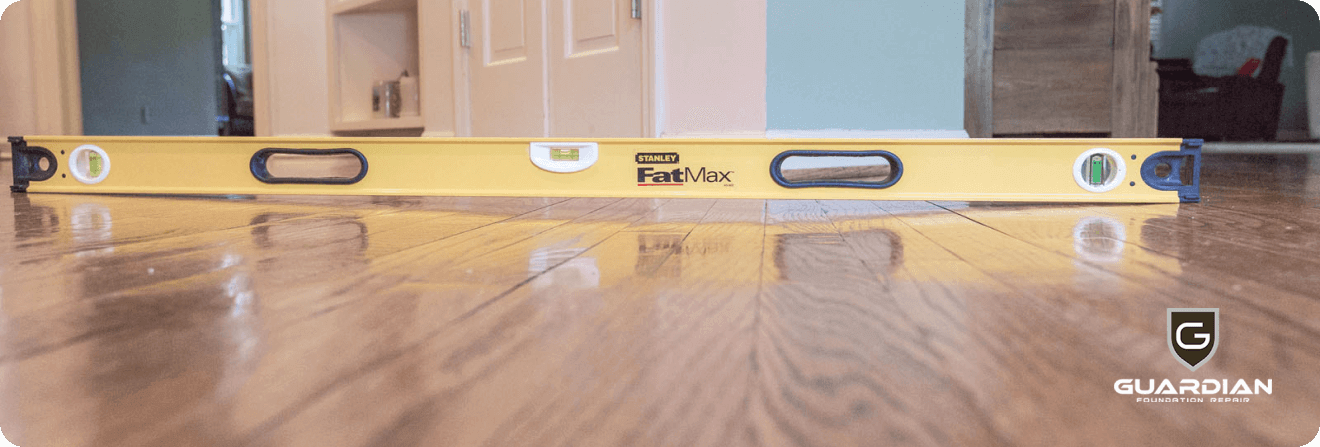Introduction:
Have you ever felt a slope or sagging floor in certain areas of your home and ignored it, thinking it was your imagination? Well, it most certainly was not!
Floor sagging is a common problem many homeowners in Knoxville’s face, especially in older homes. This can be unsightly but can also be dangerous to individuals with mobility issues giving rise to potential falls or accidents.
There are many causes for floor sagging; if left untreated, it can pose a serious health hazard to the home’s occupants.
This article will explain what causes floor sagging and solutions that foundation repair contractors can help you with to fix your sagging issues.
Why Do Floors Sag?
Sagging floors are floors that slump or bend downwards in the middle creating an uneven surface that can be felt when walking across the area. But floors themselves are rarely the cause of this issue. As a house structure ages, the soil beneath it naturally shifts, and the weight of the house can cause it to sink, resulting in uneven floors.
All types of foundations can cause sagging floors, but they are more commonly found in homes with a crawl space, basement, or slab foundation. It is thus crucial to identify the cause of floor sagging before attempting to fix it to avoid further damage.
Major Causes of Uneven Floor:
Excess Moisture:
Water damage or moisture is one of the most common causes of floor sagging – when water penetrates the foundation, it weakens the support system causing the wooden beam and sub-flooring to rot and warp. This water damage can be caused by:
- Heavy rains and flooding
- Leaking pipes and drains
- Gutters that are not properly installed
- Inadequate drainage around a home’s foundation
- Groundwater seeping into the crawlspace or basement
Also, in climates characterized by freezing temperatures, moisture can get trapped beneath the slab foundation resulting in frost heaves which cause buckling and heaving of the soil. All these changes eventually lead to sagging and uneven floors, and at times it may even trigger cracks in the foundation, rot, and mold growth.
Poor Structural Design:
A damaged foundation is often caused due to a faulty structural design. This can include:
- The long span of joists and beams
- Improper spacing between joists and beams
- Undersized or improper support posts or footings
- Improperly distributed weight on the floor
If a house is not constructed as per the building codes, your floor may start sagging over time due to the extra weight it cannot support.
In the case of an older home, the foundation weakens over time, causing joists, floors, and walls to warp. This may eventually lead to serious structural damage, such as cracks in foundation walls.
Soil Shifting:
Soil moves and shifts naturally over time due to climate changes, vibrations, and tree roots. When the soil is wet, it expands, and when dry, it contracts; this puts extra pressure on the foundation and jack posts, causing them to move, tilt and settle.
When this happens, the floors on the upper level become uneven and start to sag. Thus, builders must compact the soil beneath it before laying the foundation to prevent further shifting and settling.
Improper Compact Fill:
Improperly compacted fill beneath the foundation can cause sagging floors. Compacting the soil is essential when building a home as it prevents soil shifting and settling, which helps maintain the foundation’s stability.
When there is inadequate compaction fill, it nullifies its purpose leading to shifting and eventual sagging floorboards. Therefore, when building a new house, ensure that the fill is properly compacted. And if you are renovating an existing house, have it checked by a foundation repair expert.
Natural Sinkholes:
Sinkholes are caused by water draining into the ground and through the limestone bedrock. If the drainage around your home is poor, you can be at risk of having a sinkhole that can cause your foundation to collapse and the floors to sag.
It is important to keep an eye out for signs of sinkholes, such as:
- Higher water bills
- Pooling water near the foundation
- The unusually green lawn surrounding your home
Contact a foundation repair contractor immediately if you suspect your home is at risk of a sinkhole.
Related Reads: Factors that can damage your home foundation.
How to Fix Floor Sagging:
Once you realize your home has a sagging floor, you need to fix it before the problem worsens immediately. It is recommended to use a professional foundation repair service as they specialize in this area and can help you find the best solution for your home.
Some of the common solutions professional foundation services use to fix sagging floors include:
Foundation Peering:
Foundation Peering is one of the most common solutions used by foundation repair professionals to fix slopes and sags. The method involves pumping grout into the strategically placed holes to lift the foundation and fill any gaps. The push pin pier system is beneficial as it helps prevent future settling and reinforces your home’s structure.
Fixing of Leaky Plumbing Pipes:
Water leakages from plumbing pipes need to be fixed as soon as possible. A cracked or broken pipe can cause water to erode and weaken the soil, leading to sagging floors. Examine the piping around your home and inspect them for signs of leakages; if any are found, contact a professional plumber to repair it.
Reinforce the Floor Joists:
If the sagging on your floor is between two joists, the beams can be reinforced by sistering it with a new joist. Floor joist repair involves joining a new piece of lumber beside the existing support beam to provide additional support. Adjustable jacks are then used to lift and level the sagging floor joist. If the floor joist is too weak to sister, they need to be replaced.
Effective Drainage System:
Soil movement from soil shifting can be prevented by having an effective drainage system. The soil around your home needs to drain away from the foundation, so install a drainage system that will direct water away from rainwater or other sources of moisture.
Waterproofing your home can also help reduce water staining and moisture damage to your foundation. This can be done by installing a damp-proof membrane around the exterior of your home or even using waterproof sealant on all corners of your home.
Get Your Floor Sagging Fixed By Professionals:
Sagging floors are not to be taken lightly as they can cause hazards such as falls, trips, and sometimes serious injuries to you or your family. If you have a sagging floor in your home, contact a specialist to help you fix the issue. Professional house foundation repair contractors are experienced and well-equipped to address this issue and can help restore the structural integrity of your home.
Guardian Foundation Repair is a leading foundation repair company in the Knoxville area. Our experts can provide you with a full range of solutions to fix your sagging floors, crack foundation repair, downspout leader installation, and more.
Contact us today for more information about our services and how we can help make sure your home is safe and free from sagging floors.
Let our team help you get your home back to its former glory!


